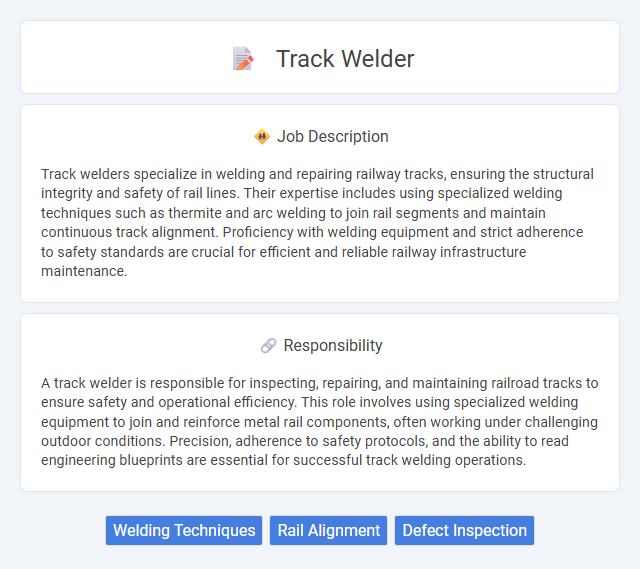
Track welders specialize in welding and repairing railway tracks, ensuring the structural integrity and safety of rail lines. Their expertise includes using specialized welding techniques such as thermite and arc welding to join rail segments and maintain continuous track alignment. Proficiency with welding equipment and strict adherence to safety standards are crucial for efficient and reliable railway infrastructure maintenance.
Individuals with strong physical stamina and good hand-eye coordination are likely to be suitable for a track welder job, as the role often requires working in demanding environments and handling heavy equipment. Those who may struggle with prolonged outdoor exposure, confined spaces, or irregular hours might find this occupation challenging. A predisposition towards safety awareness and precision could increase the probability of success in this field.
Qualification
Track welders must possess specialized qualifications, including certification from recognized bodies such as the American Welding Society (AWS) or equivalent international standards. Proficiency in welding techniques like Shielded Metal Arc Welding (SMAW) and Flux-Cored Arc Welding (FCAW) is essential for ensuring the durability and safety of railroad tracks. Strong knowledge of railroad engineering principles and adherence to safety protocols are critical qualifications for successful track welding professionals.
Responsibility
A track welder is responsible for inspecting, repairing, and maintaining railroad tracks to ensure safety and operational efficiency. This role involves using specialized welding equipment to join and reinforce metal rail components, often working under challenging outdoor conditions. Precision, adherence to safety protocols, and the ability to read engineering blueprints are essential for successful track welding operations.
Benefit
Track welders likely experience benefits such as competitive wages due to the specialized nature of their skills and the demand for railway infrastructure maintenance. Access to health insurance and retirement plans may be probable, reflecting industry standards and union agreements. Opportunities for training and career advancement could increase job security and long-term earning potential in this role.
Challenge
Track welder jobs likely present significant challenges due to the high precision and safety standards required in welding railway tracks. The probability of encountering difficult working conditions such as outdoor environments and varying weather increases the complexity of the role. These factors may demand advanced technical skills and careful attention to detail to ensure the integrity and longevity of railway infrastructure.
Career Advancement
Track welders specializing in railroad and heavy machinery welding can advance their careers by gaining certifications such as Certified Welding Inspector (CWI) or Advanced Structural Welding. Mastery of cutting-edge welding technologies and joining techniques enhances job prospects for supervisory or project management roles within rail infrastructure companies. Continuous skill development and hands-on experience in diverse welding environments contribute to higher earning potential and leadership opportunities in the track construction industry.
Key Terms
Welding Techniques
Track welders specialize in joining rail components using advanced welding techniques such as arc welding, MIG (Metal Inert Gas) welding, and TIG (Tungsten Inert Gas) welding for precision and durability. Proficient use of thermite welding ensures seamless rail joints by melting and fusing metals at high temperatures, crucial for maintaining track integrity. Expertise in weld inspection and fracture testing guarantees safety and longevity of railway infrastructure under dynamic loads.
Rail Alignment
Track welders specialize in joining rail segments to ensure continuous, smooth tracks essential for safe train operations. Precise rail alignment is critical in their work to maintain track geometry, reducing wear and preventing derailments. Expertise in welding techniques and measurement tools supports optimal rail positioning and long-term track stability.
Defect Inspection
Track welders play a critical role in defect inspection by meticulously examining welded rail joints to ensure structural integrity and safety. They use advanced non-destructive testing techniques such as ultrasonic testing, magnetic particle inspection, and visual assessment to detect flaws like cracks, porosity, or incomplete fusion. Accurate defect identification prevents rail failures and enhances the longevity and reliability of railway infrastructure.
 kuljobs.com
kuljobs.com